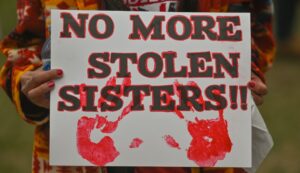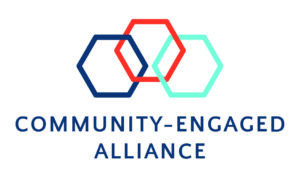BY MIC BUCHWITZ, KYLIE BARKLEY, AND THOMAS CRAIN
 In the United States and Canada, thousands of Indigenous women and girls disappear and are murdered every year. In 2018, a study completed by Urban Indian Health Institute found that out of 506 cases, nearly 27% of victims were 18 years old or younger, and among the cases where age was recorded, the average age was only twenty-nine years old. Infants and elderly women were also identified as victims. However, the report stresses that these 506 cases identified do not represent the true number of missing and murdered Indigenous women and girls. In urban areas, the numbers are likely much higher than reported.
In the United States and Canada, thousands of Indigenous women and girls disappear and are murdered every year. In 2018, a study completed by Urban Indian Health Institute found that out of 506 cases, nearly 27% of victims were 18 years old or younger, and among the cases where age was recorded, the average age was only twenty-nine years old. Infants and elderly women were also identified as victims. However, the report stresses that these 506 cases identified do not represent the true number of missing and murdered Indigenous women and girls. In urban areas, the numbers are likely much higher than reported.
Red Dress Day was created to honor Missing and Murdered Indigenous Women, Girls, and Two-Spirit People (MMIWG2S+) and spread awareness about the MMIWG2S+ crisis. Red Dress Day takes place on May 5th and involves protests and events honoring MMIWG2S+. Red dresses and red handprints symbolize MMIWG2S+ and are often displayed during Red Dress Day. This semester, students in Dr. Holly Cusack-McVeigh’s Community Collaboration and Curation class from Indiana University Indianapolis (IUI) installed Boontak (Stop It!): Stolen Daughters of Turtle Island. This special exhibition, on display at the Ziibiwing Center of Anishinabe Culture and Lifeways through August 29, 2025, is aimed at educating visitors about Red Dress Day and the MMIWG2S+ crisis. The Ziibiwing Center shares the story of the Saginaw Chippewa Indian Tribe of Michigan and educates visitors about Anishinabe culture. The Ziibiwing Center was specifically chosen to display this special exhibit during the community’s No More Stolen Sisters Event in May.
The MMIWG2S+ movement started as a response by Indigenous women to increased violence, sexual assault, and human trafficking surrounding man camps in Canada and the United States. The term “man camp” refers to temporary housing built by major companies for non-Indigenous workers that are often built around Native American reservations. However, violence against Indigenous women, girls, and Two-Spirit people began centuries before the movement was founded. Initial European colonization of Indigenous peoples resulted in genocide, forced assimilation into Western culture, and the theft of Indigenous lands. These violent systemic processes directly contributed to the current MMIWG2S+ epidemic.
According to the National Indigenous Women’s Resource Center, murder is the third leading cause of death for Indigenous women and girls, and more than four out of five Indigenous women (84.3%) have suffered from violence at some point in their lives. Additionally, the Transgender Law Center reports that at least twenty-five transgender and Two Spirit individuals were murdered or went missing since 1990. The realities of missing and murdered Indigenous women, girls, and Two-Spirit people are often obscured by inconsistencies in how law enforcement, media, and communities understand the scope of this crisis. Studies have shown that relying solely on official reports or media coverage presents an incomplete and often inaccurate picture, minimizing the extent of violence experienced by Indigenous communities. These gaps in awareness and documentation make it more difficult to address the issue through policy, programming, and advocacy.
The Ziibiwing Center’s special exhibit, Boontak! (Stop it!): Stolen Daughters of Turtle Island, serves as a powerful tribute to Missing and Murdered Indigenous Women and Girls. Through a combination of striking photographic images, storytelling, and historical documentation, this exhibit sheds light on the ongoing crisis while honoring the lives of those lost. At its heart are ninety-four portraits of Indigenous women and girls who volunteered to symbolically stand in for those who are no longer with us, ensuring they are seen and remembered. The exhibit also features red dresses, an enduring symbol of the MMIWG2S+ movement, serving as a visual reminder of lives stolen and the urgent need for justice.
This physical exhibit was installed with the assistance of students from IU Indianapolis’ Community Collaboration and Curation class. While their role focused exclusively on installation, their efforts helped bring the exhibit to life within the Ziibiwing Center’s space. The in-person exhibit differs from the online version, which includes additional historical context, personal testimonies, and advocacy resources, and instead emphasizes a deep connection with the women and girls pictured. However, both serve the same vital purpose – honoring those lost, raising awareness, and demanding action.
The exhibit is more than an educational display – it is a call to action. By amplifying the voices of Indigenous communities, it seeks to raise awareness about the systemic factors contributing to the MMIWG2S+ crisis and the urgent need for justice. Through initiatives like Red Dress Day and exhibits such as this one, communities are honoring lives lost while fighting for systemic change. But remembrance alone is not enough – advocacy, education, and solidarity must persist beyond a single event or exhibit. Raising awareness by sharing stories, supporting Indigenous-led organizations, and participating in efforts for justice are all meaningful ways to contribute. Standing in solidarity, whether through conversations, donations, or legislative advocacy, helps push for lasting change and ensures that the voices of MMIWG2S+ are heard, remembered, and acted upon. The responsibility to stand against this crisis belongs to all of us.
For important resources for families, communities, advocates, and journalists, see the National Indigenous Women’s Resource Center for more information.

This community-based, collaborative project was funded through a High-Impact Community Engagement Practices (HIPSs) award from the Community-Engaged Alliance (CEA). The CEA Mission “enables students to create positive social change by advancing the field of community engagement in higher education through support, education, and collaboration with partners.” Learn more at https://communityengagedalliance.org/about/
Kylie Barkley is a first-year graduate student in the Museum Studies Program at Indiana University Indianapolis.
McKayla “Mic” Buchwitz is a second-year graduate student in the Museum Studies Program at Indiana University Indianapolis.
Thomas Crain is a first-year graduate student in the Museum Studies Program at Indiana University Indianapolis.

